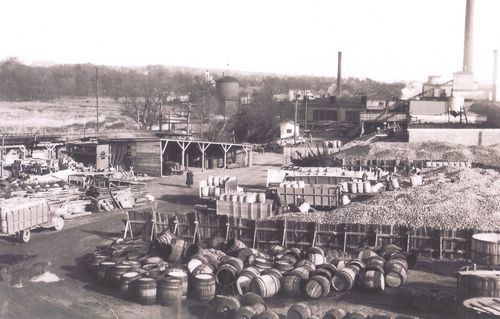Dominion Atlantic Railway Digital Preservation Initiative - Wiki
Use of this site is subject to our Terms & Conditions.
Canada Foods Plant

The Canada Foods Plant was a fruit and vegtable processing factory in Kentville located immediately wesy of the Kentville Roundhouse on West Main Street from the 1940s until 2016. It was one of the DAR's largest customers in postwar Kentville. The plant was built by M. W. Graves in the middle of World War Two to expand his large fruit processing business in Berwick with a potato drying plant to serve the booming market for army rations. Graves purchased the land beside the roundhouse owned by Herbert Dennison for the plant. The Dennison barn, which had often appeared in DAR photos at Kentville was demolished to make room for the plant. A portion of the ridge along West Main Street was levelled to create fill to divert the Cornwallis River to make a large storage yard for the plant by the river. The factory was a 300-foot-long building which included a tall brick chimney lettered "Canada Foods" which loomed behind the Kentville Roundhouse and appears in many DAR yard photos. The Canada Foods was the largest potato dehydration plant in the British Commonwealth during the war. It was served by a 750-foot-long spur running off the North 4 track of the Kentville Railyard.[1]
In 1950, with the drop in demand for army rations, the plant was re-organized to produce juice and pickles and employed 45 men and 90 women during its peak fall and winter operating seasons. The plant purchased the Kentville Roundhouse from the DAR in the 1960s and converted it to a warehouse, connected to the Canada Foods Plant by a conveyor and covered passageway. In October 1966 the plant was heavily damaged in a major fire at the height of its fall operation. Cement blocks and metal containers were blown 300 feet across the DAR Kentville Railyard yard tracks. A string of boxcars along the plan spur containing juice, frozen blueberries and machinery was also destroyed. A DAR locomotive crew braved the explosions to back a locomotive along the burning building and remove a tank car that was full of fuel and next to the burning plant.[2] Fire fighters managed to save the pickle plant at the west end and the storage building on the east end. The plant was quickly rebuilt within weeks.[3] Rail shipments in the late 1960s were 240 to 250 inbound cars a year and 100 to 160 outbound cars per year.[4]
Graves sold his valley operations in the 1960s and the Canada Foods Plant continued under several other owners. Its final owner, Great Valley Juices, owned by the Quebec-based A. Lassonde company, transferred most of the production work to a new factory in Port Williams. The Canada Foods Plant became mainly a warehouse for the Port Williams factory. The warehouse was closed in 2014 and demolished by Great Valley Juices in June 2016.[5]
Gallery
Canada Foods Plant at the West Main Street, "Dennison's Crossing", circa 1948.
Canada Foods Plant and switchstands of the Kentville Railyard, circa 1948.
Canada Foods Plant and tracks of the Kentville Railyard, circa 1948.
The Canada Foods Plant with stalls 8, 9 & 10 of the Kentville Roundhouse, plus the Kentville Water Tower, the Cornwallis River Bridge and the Spillway Trestle in 1949.
Canada Foods Plant behind the Kentville roundhouse and machine shop from the coaling tower, 1940s or 50s.
The Kentville Roundhouse with diesels No. 8135, No. 8132, No. 8137, No. 8133, No. 8140, No. 8134, the DAR Track Crane No. 3 and the Canada Foods Plant smokestack, June 12, 1960.
Canada Foods Plant and portions of the Kentville Railyard after the food plant fire, October 1966.
Canada Foods Plant and portions of the Kentville Railyard after the food plant fire, October 1966.
Kentville Roundhouse with the foundations of the Kentville Machine Shop in the foreground and the Canada Foods Plant in the background, circa 1974-1975.
South side of the Kentville Railyard looking west with the Kentville Track Scale with the Canada Foods Plant, October 1990.
Canada Foods Plant right and the Kentville Roundhouse taken from the Spillway Trestle with the Kentville Cornwallis River Bridge in the background, Fall 1991.
Kentville Railyard looking east from the West Main Street crossing with the Canada Foods Plant, the Kentville Roundhouse, and the Kentville Car Shop, 1992.
The Canada Foods Plant with the covered passageway that connected the plant to the Kentville Roundhouse just prior to the roundhouse demolition, October 10, 2007.
Demolition of the Kentville Roundhouse, with the east end of the Canada Foods Plant in the background, July 9, 2007.
References and Footnotes
- ↑ Kentville Railyard Track Plan 1974
- ↑ Facebook Post by Louis Comeau Nov. 30, 2022
- ↑ Mabel G. Nichols, Devil's Half Acre: A Look at Kentville's History 2nd edition, Kings Historical Society (2011), page 75.
- ↑ 1969 Memorandum of General Information, page 8
- ↑ Ashley Thompson, "Demolition of Great Valley Juices warehouse in Kentville underway", Kings County Advertiser/Register, June 14, 2016













